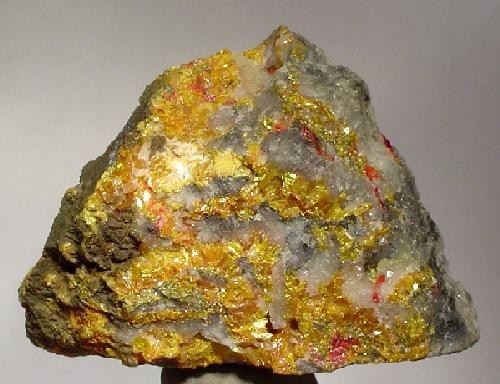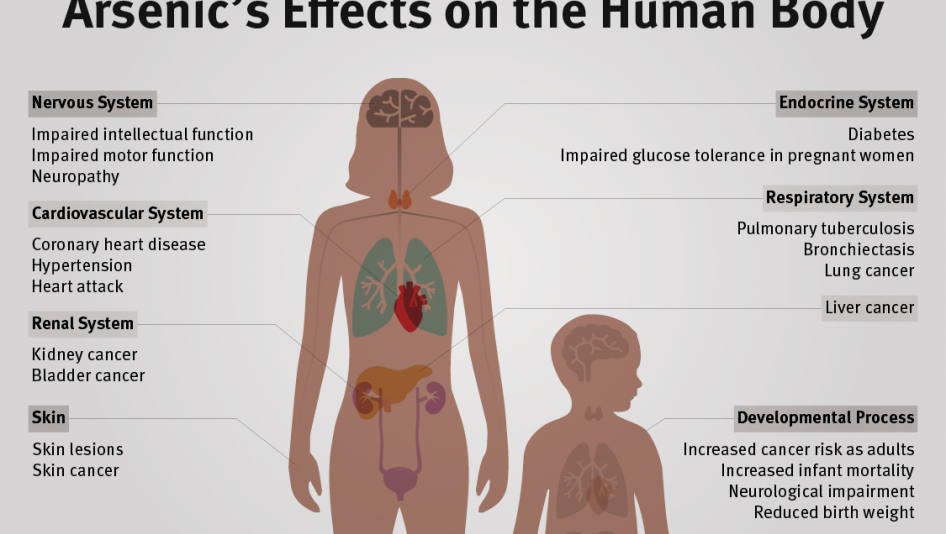Description

Disclaimer: Copyright infringement not intended.
Context
- A recent peer-reviewed study suggests that even low levels of arsenic consumption may impact cognitive function in children, adolescents, and young adults.
ARSENIC CONTAMINATION: https://www.iasgyan.in/daily-current-affairs/arsenic-contamination
Arsenic
- Arsenic is a chemical element with the symbol As and atomic number 33.
- Arsenic occurs in many minerals, usually in combination with sulfur and metals, but also as a pure elemental crystal.
- Arsenic is a metalloid. It has various allotropes, but only the gray form, which has a metallic appearance, is important to industry.
- The primary use of arsenic is in alloys of lead(for example, in car batteries and ammunition). Arsenic is a common n-type dopant in semiconductor electronic devices. It is also a component of the III-V compound semiconductor gallium arsenide. Arsenic and its compounds, especially the trioxide, are used in the production of pesticides, treated wood products, herbicides, and insecticides. These applications are declining with the increasing recognition of the toxicity of arsenic and its compounds.

Impact of Arsenic Contamination
- Arsenic is highly toxic in its inorganic form.
- People are exposed to elevated levels of inorganic arsenic through drinking contaminated water, using contaminated water in food preparation and irrigation of food crops, industrial processes, eating contaminated food and smoking tobacco.
- Long-term exposure to inorganic arsenic, mainly through drinking-water and food, can lead to chronic arsenic poisoning. Skin lesions and skin cancer are the most characteristic effects.

High Arsenic Contamination- A grave issue
- A study found that at least 108 countries are affected by arsenic contamination in groundwater. The highest among these are from Asia (32) and Europe (31), followed by regions like Africa (20), North America (11), South America (9) and Australia (4).
- A study by the Indian Institute of Technology, Kharagpur, said that almost 20 per cent of India's total land area has toxic levels of arsenic in its groundwater, exposing more than 250 million people across the country to the poisonous element. It is estimated that 20 states and four Union Territories in the country are affected by this problem now, said another study.
- The states of Punjab (92 per cent), Bihar (70 per cent ), West Bengal (69 per cent ), Assam (48 per cent ), Haryana (43 per cent ), Uttar Pradesh (28 per cent), and Gujarat (24 per cent ) show the highest areal extent of elevated groundwater arsenic zones. Most of these high arsenic areas are mostly located along the Indus-Ganga-Brahmaputra river basin and in pockets in Peninsular India.
- A 2015 report by the Central Ground Water Board (CGWB) states that traces of arsenic contaminated water have been found in 153 districts in 21 states in India are, taking the total number of people residing in arsenic affected areas to approximately 40 million. Apart from causing health hazards, arsenic contaminated water has also disrupted the food chain and its effects have been visible on edible items cultivated near the Ganga basin in Eastern India, where the levels of arsenic have been found to be unusually high.
What Is the Permissible Limit?
- The recommended limit is 10 10ug/l. Arsenic contamination in communities across India has increased by 145 per cent in the past five years, according to a report by The Guardian.
- In rural parts of the country, it is wreaking havoc in the lives of people.
- Arsenic contamination in India was widespread in the 1990s in West Bengal and later in Bihar, Jharkhand, Uttar Pradesh, Assam and Manipur.
Groundwater contamination, India’s hidden crisis
- The number of habitations affected by arsenic in India has increased from 3,728 in 2012-13 to 7,535 in 2015-16. This is because of the overuse of groundwater for irrigation and drinking.
- Arsenic previously occurred in a harmless insoluble conjugate with iron called arsenopyrite.
- Overuse has split this compound, contaminating groundwater with a soluble ionic form of arsenic.
- Over-exploitation of groundwater started in India in the 1970s when millions of tube wells were installed in the Ganga delta to prevent diarrhoea from surface water sources such as tanks, ponds and open wells.
- Today, India has over 30 million groundwater extraction points.
- Groundwater is also used for irrigation. This means arsenic poisoning affects not just the people of the area but also those who consume the produce of the affected region. In food, rice has the highest sensitivity to arsenic followed by vegetables. In most arsenic-affected states rice is the staple.
- India’s large rift-zone contains iron silicon magnetic rocks, which are rich in arsenic. The presence of arsenic containing minerals, such as biotite, magnetite, limonite, olivine, pyroxene, and amphiboles also elevate arsenic concentrations in groundwater. Arsenic poisoning through drinking and cooking with arsenic-laden water is reported across the nation.
- Crops watered with arsenic-laden groundwater contaminate food grains and vegetables. These contaminated food grains affect people’s lives and livelihoods. Prolonged consumption of arsenic laden water and grains can lead to arsenic poisoning, hormonal disturbance, neurobehavioral abnormalities, tumours, and cancers of the liver, prostrate, kidney, lung and bladder. Arsenicosis is a deteriorating and disabling disease, which causes skin lesions and pigmentation on skin, palm and soles. Deterioration in physical appearance makes people socially excluded.
- Arsenic contamination at an elevated range in any region can impact society through disability, poverty and societal stress. The majority of people affected by arsenic contamination in India live in rural areas and are not aware of the poisoning and possible treatment procedures.
Concern
- Despite the crisis, groundwater contamination by arsenic does not get the attention it deserves, especially when compared to surface water contamination because the latter is visible. Moreover, there is no law yet to check groundwater withdrawal.
Tackling the issue
- This severe environmental-health crisis has to be contained quickly before it can expand.
- Along with periodic testing of water in affected areas and individualised testing of each hand pump or tubewell (marking it as safe/unsafe), it is important to encourage people to opt for low-cost, local solutions such as rainwater harvesting that can ensure clean drinking water.
- States such as Bihar have set up filtration units but the maintenance of filters has always been a problem. This needs to be addressed.
- Additionally, governments have to curb the use of groundwater and keep a strict control on agricultural and industrial effluents that pollute aquifers that recharge groundwater.
- Creating awareness and providing proper medical care to arsenic-affected people can help to reduce the poisoning and extend lives.
- Along with periodic testing of water from affected areas, individualised testing of each hand pump or tubewell (marking it safe/unsafe), it is important to encourage people to opt for low-cost, local solutions like rainwater harvesting that can ensure clean drinking water.
- The available arsenic remediation technologies are precipitation, adsorption, membrane filtration, reverse osmosis, ion exchange, phytoremediation, and biological treatment. But these technologies are highly dependent on electricity and thus are too costly for poor people.
- Apart from these, an in-situ arsenic remediation technology is a permeable reactive barrier. A permeable reactive barrier is a column filled with different materials such as zero valent iron and furnace slag embedded with sulphur reducing bacteria. These columns adsorb arsenic and restrict them from accumulating in water. These columns can be fixed into the water table. Ignorance of these remedies is a major challenge for India.

Closing Remarks
- Clean water and sanitation are primary necessities of a healthy society.
- Every citizen has a right to clean water under Article 21 of the Indian constitution.
- Policy makers should encourage public awareness about arsenic contamination.
- The state and Union governments should work hand in hand to develop feasible technologies to clean arsenic-laden water.
- Most of the technologies developed to treat arsenic-laden water never leave laboratories, and are therefore useless to tackle this problem.
- A single government body will find it difficult to tackle the problem of arsenic contamination on its own. Cooperation between the Ministry of Water Resources, River Development and Ganga Rejuvenation, the CGWB, the respective state governments and their arsenic task forces and NGOs which work in the field of arsenic contamination is necessary to tackle the problem wholly. Arsenic contaminated water also leads to several diseases for which the Ministry of Health needs to be roped in on how to tackle such diseases.
- Another major issue related to arsenic is the waste generated by arsenic and its indiscriminate disposal. Waste generated from purifying plants which treat arsenic laden water is hazardous and often disposed casually, resulting in extensive environmental damage. It is up to the Ministry of Environment to work in tandem with the government bodies working on the arsenic problem and issue guidelines related to arsenic waste disposal which must be followed to avoid any environmental damage.
- The problem of arsenic contaminated water also needs to be looked at by experts who can provide feasible solutions related to contaminated arsenic water. Subject matter experts who have worked extensively to understand the spread of arsenic levels in groundwater can provide suggestions related to alternative water sources in arsenic-high areas.
- Along with technological solutions, subject matter experts can identify alternate sources of water in arsenic heavy areas and advise the local population to use such sources.
- More research funds need to be allocated for further research and technology generation.
- Mitigation measures — that are currently focused on drinking water — must have a more comprehensive approach to ensure arsenic-free water for drinking and agricultural products. That means that the government must check for arsenic in water used for agricultural produce.
- Both the Union and state governments must work toward facilitating research that can investigate the accumulation of arsenic in crops and addressing the agricultural concerns of the affected regions. They must watch out for arsenic percolation in the food chain and the possibilities of biomagnification.
- The government needs to also conduct a larger study on the arsenic contamination of our food chain and its health impacts to understand its spatial spread through the agricultural supply chain. As the poison is spreading, the clock is ticking too.
- Clean (and arsenic-free) water is vital to sustain life. Protecting such water needs to be a priority for all of us.
|
PRACTICE QUESTION
Q. Arsenic contamination at an elevated range in any region can impact society through disability, poverty and societal stress. The state and Union governments should work hand in hand to develop feasible technologies to tackle the issue of Arsenic contamination in India? Comment.
|
https://www.thehindu.com/sci-tech/health/even-limited-arsenic-exposure-mars-cognitive-function/article66869761.ece












